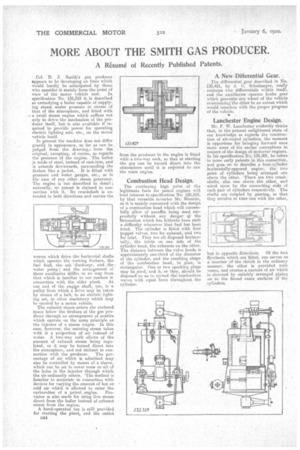MORE ABOUT THE SMITH GAS PRODUCER.
Page 26

If you've noticed an error in this article please click here to report it so we can fix it.
A Résumé of Recently Published Patents.
Col. D. J. Smith's gas producer appears to be developing on lines which would hardly be anticipated by those who gonsider it mainly from the point of
view of the motor vehicle user. In specification NO. 135,319 it. is described as embodying a boiler capable of supplying steam under pressure in excess of that of the atmosphere, and fitted with -a small steam engine which suffices not only to drive the mechanism of the producer itself, but is also available if required to provide power for operating electric lighting sets, etc., on the motor vehicle itself.
In general the machine does not differ greatly in appearance, so far as can be judged from the drawing,. from the original, excepting, of course, as regards the presence of the engine. The boiler js made of steel, instead of cast-iron, and it extends downwards, surrounding the
firebox like a jacket. It is fitted with pressure and water gauges etc., as in the case of any other steam generator. The engine is not described in detail ; naturally, no patent is claimed in connection with it. • Its crankshaft is extended in both directions and carries the worms which drive the horizontal shafts which operate the -rocking firebars, the fuel feed, the ash discharge, and ,the water pump; and the. arrangement of these auxiliaries difitia in no way from that which is familiar to our .readers in connection with the 'older plant. At one end of the engipe shaft, too, is 'a pulley from which a drive may be taken by means of a belt, to an electriclighting set, Zn. other machinery Which may be carried by a motor vehicle.
The exhaust steam enters the enclosed space below the firebars of the gas producer through an arrangement of nozzles which operate on the same principle as the injector of a steam wagon. In this case, however, the entering steam takes with it a proportion of air instead of water. A two-way coel: allows of the amount of exhaust steam being regulated, or it may he turned direct into the atmosphere, and not utilized in connection with the producer, . The per, centage of air which is admitted may also be controlled by means of a sleeve, which can be set to cover some or-all of the holes in the injector through which the airordinarily enters. The method is familiar to motoristr in connection with devices for varying the amount of hot or cold air which is allowed to enter the carburetter of a petrol engine. Provision is also made for using live steam direct from the boiler instead of exhaust steam from the engine.
A hand-operated fan is still provided for starting the plant, and the outlet C44
from the producer to the engine is fitted with a two-way cock, so that at starting the gas can be turned direct into the atmosphere until it is required to run the main engine.
Combustion Head Design.
The continuing high price of the legitimate fuels for petrol engines will lend interest to specification No. 135,318, by that versatile inventor Mr. Ricardo, as it is mainly concerned with the design of a combustion head which will successfully allow of paraffin being used successfully without any danger: of the %:letonation which has hitherto been such a difficulty whenever that fuel has been tried. The cylinder is fitted with four poppet valves, two for exhaust, and two for inlet. They are all disposed horizontally, the inlets on one side of the cylinder, head, the exhausts on tho other. The distance between the valve heads is approximately one-third of the diameter of the cylinder, and the resulting shape of the combustion head, „in plan, is rectangular: One or two sparking plugs may be used; and it, or they, should be disposed .so az to spread :the-combustion waves with equal force throughout, the cylinder.
A New-Differential Gear.
The differential gear described in No. 135,421, by J. O. Schultnayer, really contains two differentials within itself. and the auxiliaries -operate brake gear
which prevents one wheel of vehicle overrunning theother to an extent which would interfere with the proper progress of the vehicle.
Lanchester Engine Design.
Mr. F. W. Lanchester evidently thinks that!, in the present enlightened state of our knowledge as regards the construction of air-cooled cylinders, the moment is opportune for bringing forward °nee more some of his earlier conceptions in respect of the design of motorcar engines. In his specification No. 135,301, he refers to some early patents in this connection, and goes on to describe a four-cylinder horizontally-opposed engine, the two pairs of cylinders beina arranged one above the other. There are two crankshafts, also one above the other, and acted unon by the connecting •rods of each pair • of cylinders respectively. The shafts are coupled by gearing, so that they revolve in time one with the other,
but in opposite directions. Of the two flywheels which are fitted, one serves as a member of the clutch in the ordinary manner, the other is provided with vanes, and creates a. current of air which is directed by suitably arranged piping on to the finned outer surfaces of the _cylinders.


























